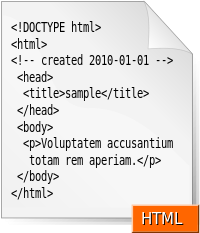HTML
".htm" and ".html" redirect here. For other uses, see HTM (disambiguation).
HyperText Markup Language, commonly abbreviated as HTML, is the standardmarkup language used to create web pages. Along with CSS, and JavaScript, HTML is a cornerstone technology used to create web pages,[1] as well as to create user interfaces for mobile and web applications. Web browsers can read HTML files and render them into visible or audible web pages. HTML describes the structure of a website semantically and, before the advent of Cascading Style Sheets (CSS), included cues for the presentation or appearance of the document (web page), making it a markup language, rather than aprogramming language.
HTML elements form the building blocks of HTML pages. HTML allows imagesand other objects to be embedded and it can be used to create interactive forms. It provides a means to create structured documents by denoting structural semantics for text such as headings, paragraphs, lists, links, quotes and other items. HTML elements are delineated by tags, written using angle brackets. Tags such as
<img /> and <input /> introduce content into the page directly. Others such as <p>...</p> surround and provide information about document text and may include other tags as sub-elements. Browsers do not display the HTML tags, but use them to interpret the content of the page.
HTML can embed scripts written in languages such as JavaScript which affect the behavior of HTML web pages. HTML markup can also refer the browser toCascading Style Sheets (CSS) to define the look and layout of text and other material. The World Wide Web Consortium (W3C), maintainer of both the HTML and the CSS standards, has encouraged the use of CSS over explicit presentational HTML since 1997.[2]
HTML5 variations
WHATWG HTML versus HTML5
Main article: HTML5
The WHATWG considers their work as living standard HTML for what constitutes the state of the art in major browser implementations by Apple(Safari), Google (Chrome), Mozilla (Firefox), Opera (Opera), and others. HTML5 is specified by the HTML Working Group of the W3C following the W3C process. As of 2013 both specifications are similar and mostly derived from each other, i.e., the work on HTML5 started with an older WHATWG draft, and later the WHATWG living standard was based on HTML5 drafts in 2011.[79][80]
Hypertext features not in HTML
HTML lacks some of the features found in earlier hypertext systems, such assource tracking, fat links and others.[81] Even some hypertext features that were in early versions of HTML have been ignored by most popular web browsers until recently[when?], such as the link element and in-browser Web page editing.
Sometimes Web services or browser manufacturers remedy these shortcomings. For instance, wikis and content management systems allow surfers to edit the Web pages they visit.
WYSIWYG editors
There are some WYSIWYG editors (What You See Is What You Get), in which the user lays out everything as it is to appear in the HTML document using agraphical user interface (GUI), often similar to word processors. The editor renders the document rather than show the code, so authors do not require extensive knowledge of HTML.
The WYSIWYG editing model has been criticized,[82][83] primarily because of the low quality of the generated code; there are voices advocating a change to theWYSIWYM model (What You See Is What You Mean).
WYSIWYG editors remain a controversial topic because of their perceived flaws such as:
- Relying mainly on layout as opposed to meaning, often using markup that does not convey the intended meaning but simply copies the layout.[84]
- Often producing extremely verbose and redundant code that fails to make use of the cascading nature of HTML and CSS.
- Often producing ungrammatical markup, called tag soup or semantically incorrect markup (such as
<em>for italics). - As a great deal of the information in HTML documents is not in the layout, the model has been criticized for its "what you see is all you get"-nature.[85]
- source wikipedia

Comments
Post a Comment